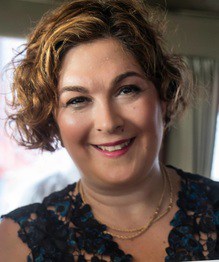Patricia Eszter Margit

Art Kibbutz is one of the first Jewish arts organizations that has succeeded in bringing the Jewish perspective through high quality art projects into important 21st century public discourses in the broader cultural sphere. Our team believes that our tradition has something meaningful to say and arts can be a vehicle to help Jews experience and express their many different identities. Nowadays the mainstream art and literary world is interested in hearing these pluralistic Jewish voices. Surprisingly, such outstanding institutions reached out to work with us as the New Museum, Governor’s Island Trust Fund, the Center for Fiction, or the Armory Show. One of our exhibitions, “Rooted: The Ecological Duality of Nature and Jewish Identity” was selected into ArtCop21, an exceptional global festival of art and cultural activity on climate change that ran in conjunction with the United Nations Climate Summit in Paris (COP21). We were the only Jewish participant at the campaign.
These experiences made us realize that the doors are wide open to us outside of our community. Artists and activists have been working hand in hand for decades. Ironically, within the Jewish community there still is a long way to go when it comes to understanding the role of artists and creatives in informing newly emerging concepts of Jewish identity. As Jürgen Habermas, German sociologist and philosopher has noted, paradigms shift through discourses in the public sphere. This is what art can do. While it is essential to provide ‘safe spaces’ for internal Jewish conversations, it is also time to step outside our community and participate in larger, society-wide conversations as Jews.
Even though artist residencies might not produce the quick, easily measurable results most Jewish donors are looking for, they do have the potential to create ‘real experiences’, that the artists bring home with themselves –and later when they create their artwork, films, books, or music, they are able to bring their perspective to the broadest audiences – their products might even last beyond our lifetime.
We believe that artists can offer new, and fresh voices to the Jewish conversation as well as the most important societal discourses that are going on beyond the Jewish community. We try to make these connections. Consider feminist writers, or environmental artists – many of whom are Jewish – but so often, they leave their Jewish identity behind when presenting themselves in a public role. If there is a need, we try to help creatives bring different segments of their identities together.
Art Kibbutz’s work is aligned with at all Rabbi Sid Schwarz’s four propositions.
Chochma: Art Kibbutz, an international Jewish artist residency program, aims to provide a meaningful Jewish connection to all artist residents who come to work, present, and connect at our space. What that Jewish connection means for each and every one of them is different. Our constituency is so diverse in age, nationality, religious, social status and professional level that the only way to create a meaningful experience for every single one of them is to provide a vessel and allow them to fill it.
We do not want to define their experience. There are several rabbis, scholars-in-residence, curators, or artistic directors present, but we make sure they do not define what Jewish art is supposed to be. Instead we try to empower artists to eventually become their ‘own Rabbi’. In Tobi Kahn’s words, artists have a ‘new Torah’ to teach and we empower them to do so. We provide all the ‘invisible miracles’ that can make that happen. First and foremost a supportive, open, and safe environment where they could let their creativity flow and find their own way. Secondly, we provide regular artists’ beit midrash and community building sessions with all other Jewish resources necessary.
Kehilla and kedusah: One of our goals is to create community. Fifty percent of participants regularly return to our residencies, many of them have been to all our programs. Art Kibbutz follows in Limmud’s footsteps: it is almost entirely driven by volunteers on a shoe-string budget. Artists pay a small fee to participate in our residencies but prices are based on a survey of what the majority could afford. Artists pay on a sliding scale so those who cannot afford the full sum have the option to volunteer. This model generates a sense of ownership for the artists and helps them break away from the ego-driven, market-dominated, highly competitive art and literary world. It also serves as a first step towards a more community-oriented mind-set.
Tzedek and more: Our programming committee chooses a ‘theme’ for the year. We arrange learning opportunities around that theme with leading experts from the field and encourage artists to create artwork related to those themes that they can discuss with each other and then present to the broadest public. None of this is obligatory. Our themes are based on the interest of the artists and have included environmental issues, shmita, social justice, LGBTQ rights, women’s rights, social inequality, and responses to rapidly growing anti-Semitism, racism, and hatred.
Patricia Eszter Margit is the founder of Art Kibbutz, international Jewish artist residency, community, and a hub. She is a bestselling author in her native Hungary, currently living in New York.
Is this post useful and interesting? Please consider sharing it with your social networks, and leave a comment below telling us your thoughts!

